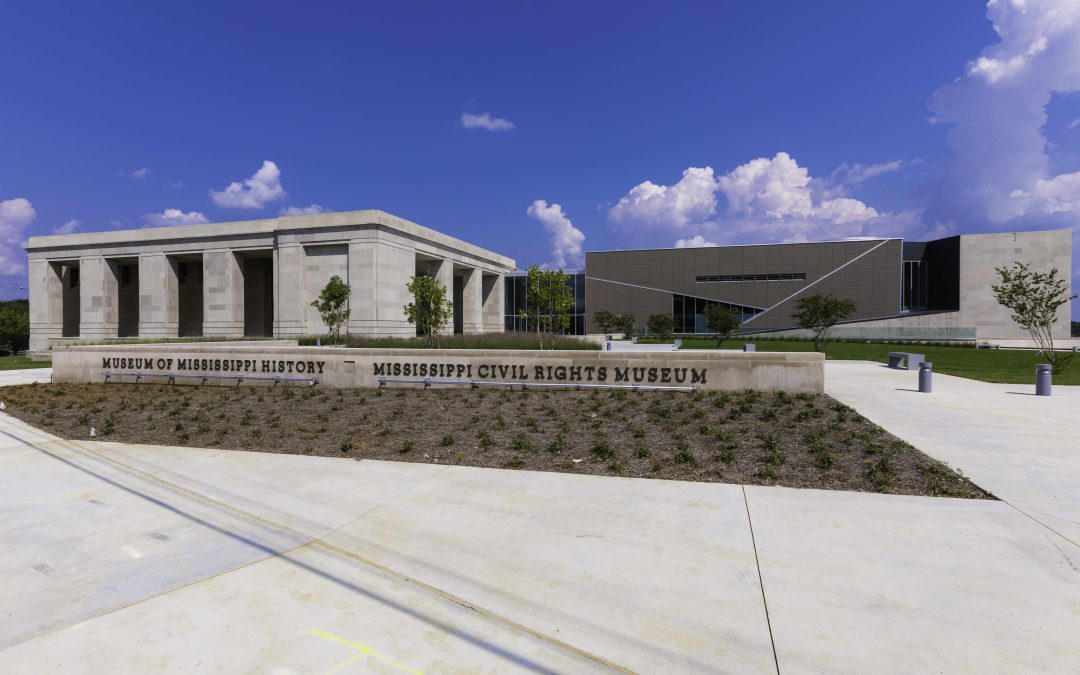* article published after the museums opening in 2017.
Last year, the state of Mississippi celebrated its 200th year of statehood—a milestone worthy of celebration as well as reflection. Helping tell the story of how we got here are two new museums in Jackson, the Museum of Mississippi History and the Mississippi Civil Rights Museum, that opened their doors in December.
Although entirely separate, the museums are housed together under one roof and share a reception area, café, theater, auditorium, and shop. Both feature strong visuals, interactive experiences, and exhibits that tell the stories of Mississippi history and all of its complexities. Together, they present a full historical picture of Mississippi.
While the state of Mississippi is only 200 years old, its history dates back thousands of years as the land was settled first by Native Americans and later European explorers. This full history is on display at the Museum of Mississippi History.
The museum is made up of 11 galleries that move chronologically through 15,000 years of history, exploring how Mississippians lived with detailed recreations of settings and interior spaces. Museum highlights include impressive life-size models of an enslaved family’s cabin and an antebellum mansion. Director Rachel Myers says, “A focus on the home and other material items allows guests to make a personal connection to the past.”
The museum is filled with a noteworthy collection of artifacts, including spear points, a carriage from Prospect Hill Plantation, and a dugout canoe that was preserved for more than 500 years. The last gallery in Museum of Mississippi History is called “Reflections,” and visitors are encouraged to share their own Mississippi story in a video recording booth. Myers says people are using this opportunity to share family stories. “The museum elicits a lot of stories and emotions, and people are uncovering and finding their Mississippi story here and then sharing them with us,” she says.
The Mississippi Civil Rights Museum is the first state-sponsored civil rights museum in the country. The museum does not shy away from presenting Mississippi’s troubling civil rights record. Throughout its eight galleries, the museum covers every facet of the Civil Rights Movement, beginning with the end of the Civil War and with a majority of the focus on events in the World War II era through the 1970s.
The second gallery, “Mississippi in Black and White,” transports visitors back in time, and the reality of the Jim Crow era is made clear through images, including five monoliths engraved with the names of lynching victims. Museum director Pamela Junior says that this transformation can affect people. “Visitors are emotional and sometimes upset, but ultimately come out with courage, a fighting spirit, knowing that the work is not over,” Junior remarks.
The jewel of the museum is in the third gallery, “This Little Light of Mine.” It’s an open space featuring large windows and a stunning interactive light sculpture that honors and celebrates civil rights activists who were killed during the movement. As more visitors gather around the sculpture, it shines brighter, and music plays louder. The symbolism is clear—everyone has a light, and if we come together, our collective lights will shine brighter.
Junior says that a visit can be overwhelming but hopes visitors take some time for contemplation. In the last gallery, “Where Do We Go from Here,” guests are provided cards and encouraged to write down what they can do after leaving and to offer ideas to come together to make Mississippi better.
Visitors to the museums can expect to spend about two hours on each side. A dual ticket is $12 and is good for two consecutive days. Myers says that many are finding the two-day tickets useful not only for the wealth of information that is available to take in, but the toll it has on visitors. “It’s hard on the mind, and it stirs lots of emotions. It can be tough to process it all in one trip,” she says.
While the museums are separate, it’s easy to see that you can’t have one without the other; a trip to only one side would be incomplete. As Myers puts it, “The two museums are in conversation; they complement each other. Each can stand on its own, but to get a full picture of the state’s history, you need both.”
Mississippi has a rich and complex story, and neither museum is shying away from that history. It’s all on display here, including natives, early settlers, enslaved people, and women. While history buffs may know the highlights of headlines, the museums illuminate the stories of ordinary people not covered in history books or taught during school. The result is that people are surprised to be learning a new side of their state’s history.





